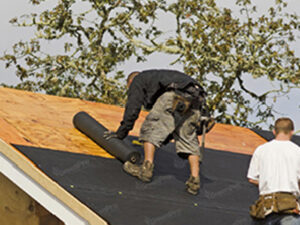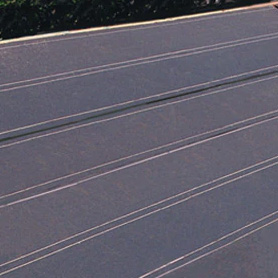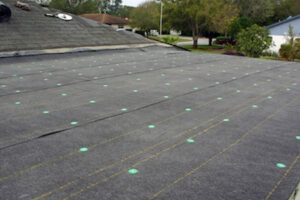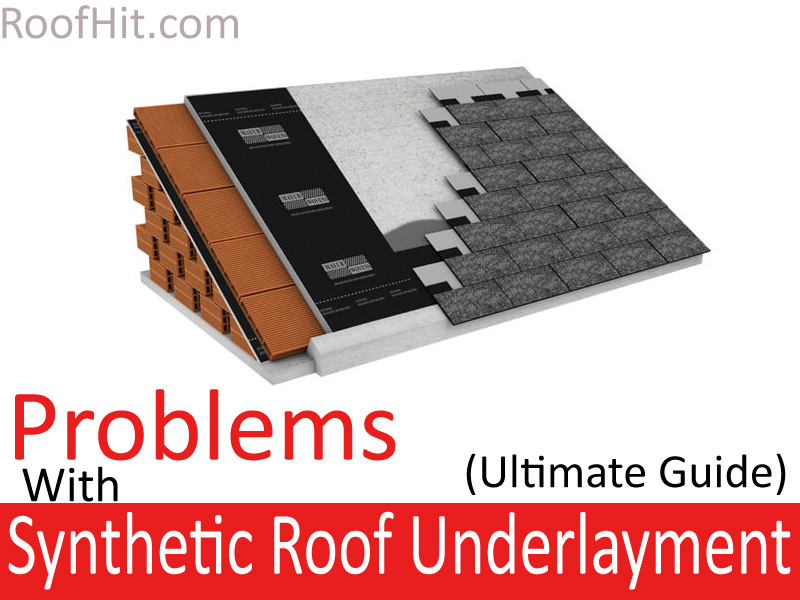The roof is an essential element of the construction, and this does not have a margin of compromise on the quality of the material or the type of roof used.
Quality must be good enough for the top to stay longer or avoid any uncertain mishaps of the roof falling. The roof needs to be strong enough to have it for years.
For this purpose, underlayment is a very reliable and reasonable option. While many types of Underlayments are available in the market, synthetic underlayment remains the popular choice of users due to its exceptional features.
However, there are some problems with synthetic roof underlayment, which will be discussed in the article below.
The article will illustrate the synthetic roof underlayment in detail, considering the most discussion about the quality and durability of this type of underlayment. And what possible problems can result from the use of synthetic underlayment.
In addition, to know best about the product, the comparison is essential with the best available substitute in the market.
In this case, felt underlayment is the closest substitute for synthetic roof underlayment and is also under discussion regarding its features, benefits, and problems.
Lastly, the benefits of choosing both synthetic roof underlayment and felt underlayment would be discussed, keeping in view the affordability of the upper or lower middle class so that detailed descriptions regarding options must be available for every individual to choose from.
Problems With Synthetic Roof Underlayment
Roof underlayment has become essential for the constructor due to the results they get after underlying the roof.
However, synthetic roof underlayment is one of the most trusted due to its longevity and high-quality feature of refraining water from entering the shelter.
However, problems with synthetic roof underlayment sometimes outweigh its benefits and let the constructors choose felt underlayment over synthetic underlayment.
Perhaps the issues are worthy enough to be discussed before making the final decision.
Synthetic roof underlayment is one of the most expensive underlayments due to the exceptional features of longevity, durability, and high-quality material it provides.
Moreover, as the demand for this underlayment has increased in the market, many manufacturers have switched to this product, claiming to provide the best to their customers, but this is not the case every time, as not every manufacturer has succeeded in giving the best quality in terms of the material, weight, and thickness of the underlayment.
Lastly, according to construction rules and regulations, every area cannot have synthetic roof underlayment, which restricts the use of this à.
One must make sure about the area code before choosing synthetic roof underlayment.
What Is Meant By Synthetic Roof Underlayment?
The synthetic roof consists of two main elements: polyethylene plastic and lamination polypropylene. The mixture of these materials makes a durable synthetic roof underlayment placed over the original roof.
This roof layer does not let the water retain over it, and due to this such a great feature, the top stays for many years and does not get damaged due to excessive rains or other storms.
Synthetic roof underlayment is one of the most used and reliable underlayments being sold in the market, as this is the best material that should be dried on a roof to make it more durable.

Why Is It Important To Underlay A Roof?
Underlay is not necessary but is preferred to be done to increase the life and safety of the roof.
It has been seen that shelters that lack underlayment or have low-quality underlayment do not last for longer durations than underlaid or high-quality underlayment roofs.
So, for longevity, it is preferable and recommended to have an underlayment done on the top, as it has multiple benefits. Some of the benefits of roof underlayments are listed below;
-
After underlayment, a roof can be saved from any moisture that could have otherwise damaged the roof and resulted in tears.
- Increase in insulation and save your area from being extra drafty.
- During monsoon or excessive rainy season, the underlayment also acts as a soundproof roof and does not let so much rain or water sound inside the room.
-
Roof underlayment also helps to enhance the final look of the roof or ceiling, as this evens the top’s surface smoothly.
- Many roof warranties state that the roof will stay longer only if done correctly, so underlayment also helps validate your roof warranty.
Is Synthetic Roof Underlayment Durable?
The durability of the synthetic roof underlayment depends upon the manufacturer of the underlayment used.
With the rising popularity of synthetic underlayment, many companies have started making this sort of underlayment to fulfill the market demand and make profits.
However, scammers and fake manufacturers also increase in the market when the need for synthetic underlayment rises—this is even one of the root causes of the problems with synthetic roof underlayment.
High-quality synthetic roof underlayment is made of polyethylene plastic and lamination polypropylene.
Look for these in the list of materials used.
In contrast, the thickness and weight of the roof also state its quality; synthetic underlayment should be thick and lightweight enough so that it can be installed easily without any hustle and without incurring too much of the installation cost as heavy roof underlayments cause too much excess installation costs.
Look for trustworthy and renowned companies with positive reviews while buying underlayment to beware of any misleading and get the best quality and durable synthetic roof underlayment.
Problems With The Synthetic Roof Underlayment
Synthetic roof underlayment is one of the most popular in the market, but this does not eliminate the problems with this roof. Below is a detailed analysis of the issues with synthetic roof underlayment;
Expensive
Synthetic roof underlayment has unique features; the material used to make this underlayment is best to prevent water from entering the roof.

However, as with synthetic roof underlayment, exceptional features always come with extraordinary prices.
This roof is almost double the cost of other minimal substitutes available. Every construction company or individual needing an underlayment for their roofs cannot buy such an expensive one.
Though this underlayment is known for its durability, other underlayments available in the market have not been provided.
That is why synthetic roof underlayment manufacturers charge extra high prices for their customers’ durable and high-quality products.
Different Weight And Thickness
The thickness and weight of the material are essential to check the quality of the underlayment. Due to the rising popularity of synthetic roof underlayment, many manufacturers claim to have the best quality underlayment.
Still, some are just manipulating the customers with not-so-good quality underlayment.

The best way to check the quality of the synthetic roof underlayment is to check the thickness.
The complete roll should be considered to check the thickness and weight of the roof. Moreover, a part of the roll should be split up for the water-resistant feature check to evaluate its authenticity.
At times, sellers sell the low quality of B quality underlayment to customers with less or no knowledge, which causes most minor trouble as the customer gets a vast loss even after spending a lot of money.
Every Roof Does Not Go With Synthetic Underlayment
Construction companies have a set of regulations they must follow when it comes to building construction. Not every building can use synthetic roof underlayment, available in the rules and regulations.
Construction companies need to consider these rules before going for synthetic underlayment, and this should only be used if allowed; otherwise, legal problems can occur in the future.
The set of rules and regulations designed for construction companies consists of construction codes; looking for a code that does not allow synthetic underlayment is challenging.
Instead, one should look for the principles that will enable synthetic underlayment.
If yours falls into that, you must go for this utterly durable, high-quality underlayment.
Why Choose Felt Underlayment Over Synthetic Roof Underlayment?
Felt underlayment is better than synthetic roof underlayment in some perspectives, but when it comes to the quality of the material and life span, even felt underlayment can not beat synthetic roof underlayment.
Thus, the problems with synthetic roof underlayment do sometimes overweigh the felt underlayment as felt has the features of being;
Less Costly Underlayment
Synthetic roof underlayment is an expensive product available in the market and famous for its unbeatable quality and durability.

However, because of their budget, everyone does not need such a high-quality material for roof underlayment.
In such circumstances, felt underlayment becomes the priority for users as the felt underlayment is half the price of synthetic roof underlayment. This could be evidenced more by the price differentiation of both underlayments.
In the market, synthetic roof underlayment is available at 17 to 25 cents per square foot, while felt underlayment is 5 to 10 cents per square foot.
This elaborates on how extra expensive synthetic roof underlayment is, and also, users can not always have this much budget for roof underlayments.
So this process that felt underlayment is a budget-friendly product that also fulfills construction dealers’ demands but within budget limits.
Every Synthetic Underlayment Is Not Equal
To be precise, felt underlayment is less costly than synthetic roof underlayment.
So those deciding to spend on synthetic underlayment must want a high-quality and durable product in return, but this is not the case at times.
Due to multiple manufacturers in the market, all claiming that they are providing the best synthetic roof material is not correct every time.
The thickness and weight of the roof need to be considered to ensure quality. Manufacturers nowadays manipulate customers with unrealistic marketing and grab the money in return for low-quality roof underlayment.
Felt underlayment is not as expensive as synthetic underlayment. Going felt underlayment automatically reduces the risk of fraud and manipulation.
Not Every Building Approves The Material Of Synthetic Underlayment
A set of rules and regulations is designed for construction companies, which they should consider before starting construction.
That respective set contains separate rules regarding the roof underlayments according to the areas where the building has to take place.
Every room does not allow synthetic roof underlayment due to concerns also mentioned in rules and regulations. In such circumstances, felt underlayment is the second best option due to its similar features to synthetic underlayment.
To know about the rules regarding your area, you must seek guidance from the construction regulations and search for the places where synthetic roof underlayment is not allowed so that felt underlayment can be used in such areas without any hustle.
Common Problems Of Felt Roof Underlayment
Felt roof underlayment is a budget-friendly roof. Due to this feature, many people prefer it over synthetic roof underlayment, but as a result, they face numerous problems as well, which have been listed below;
- Not durable, felt underlayment does not have longevity as it needs a replacement very soon when compared to synthetic underlayment.
- Complete coverage is required for felt underlayment, as if not done so, and problems may occur in the future with the direct exposure of the roof elements.
-
Heavy, which means installing felt underlayment, is not an easy task. Heavy roof underlayments incur extra high installation costs due to serious load work.
- Felt underlayment is a bit dangerous for the roofer, too, as it is unsafe to walk on the roof while installing compared to the synthetic underlayment, which is very safe to walk on while seated.
- This roof has the drawback of frequent and early tearing, which means the top may not stay for a longer lifespan.

Choose The Best Between Synthetic Roof Underlayment Or Felt Underlayment
After reading the above article, this heading may seem unrealistic to you as the above discussion made it very clear that synthetic roof underlayment has an exceptional quality, which is not matched by any other roof underlayment in the market in terms of quality or durability.
But, still, I would suggest you read this heading for the sake of some essential information. This information will state the feature differentiation between both roofs with the view of upper or lower-middle-class users.
Synthetic Roof Underlayment
- It is expensive and better for the people who can afford high-priced roof underlayment.
- It is high quality and does not get teared up easily.
- Works as a soundproof roof at times if excess rain
- Durable: It’s an expense that, if done for one, e will benefit longer.
- Every building is not allowed to have synthetic underlayment due to the regulations issued by the construction authorities.
Felt Roof Underlayment
- Cheap is recommended for low-budget construction.
- It stays longer, too, but started to tear early.
- Installation cost is higher due to the heaviness of the felt underlayment.
- Suitable to be used in areas where synthetic roof underlayment is not allowed according to the construction regulations.

Conclusion
In light of the above-detailed discussion, a conclusion can be drawn regarding problems with synthetic roof underlayment.
This underlayment carries a bit of trouble and requires a complete understanding of manufacturers’ area code and authenticity before deciding to favor synthetic underlayment.
Thus, in terms of durability and quality, this underlayment outweighs all other underlayments available in the market, as no underlayment to date has beaten the longevity of synthetic roof underlayment.
The article further evaluates the comparison of synthetic roof underlayment with felt underlayment, which benefits users who want to know more about budget-friendly options before purchasing.
As felt underlayment is one of the cheapest and most similar features to synthetic underlayment available in the market, this underlayment still fails to beat the longevity feature that synthetic roof underlayment provides.

Arthur is a skilled roof worker with over 10 years of experience in the industry. He started his career as an apprentice and worked his way up to become a foreman.
When he’s not working on roofs, John enjoys with his family or writing posts. He is also a passionate cyclist.

